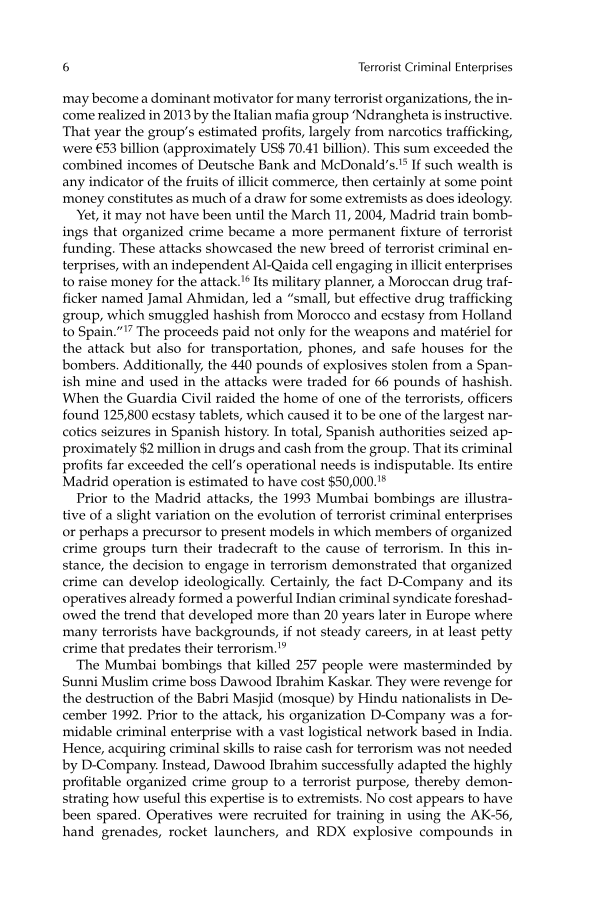6 Terrorist Criminal Enterprises may become a dominant motivator for many terrorist organizations, the in- come realized in 2013 by the Italian mafia group ‘Ndrangheta is instructive. That year the group’s estimated profits, largely from narcotics trafficking, were €53 billion (approximately US$ 70.41 billion). This sum exceeded the combined incomes of Deutsche Bank and McDonald’s. 15 If such wealth is any indicator of the fruits of illicit commerce, then certainly at some point money constitutes as much of a draw for some extremists as does ideology. Yet, it may not have been until the March 11, 2004, Madrid train bomb- ings that organized crime became a more permanent fixture of terrorist funding. These attacks showcased the new breed of terrorist criminal en- terprises, with an independent Al-Qaida cell engaging in illicit enterprises to raise money for the attack. 16 Its military planner, a Moroccan drug traf- ficker named Jamal Ahmidan, led a “small, but effective drug trafficking group, which smuggled hashish from Morocco and ecstasy from Holland to Spain.” 17 The proceeds paid not only for the weapons and matériel for the attack but also for transportation, phones, and safe houses for the bombers. Additionally, the 440 pounds of explosives stolen from a Span- ish mine and used in the attacks were traded for 66 pounds of hashish. When the Guardia Civil raided the home of one of the terrorists, officers found 125,800 ecstasy tablets, which caused it to be one of the largest nar- cotics seizures in Spanish history. In total, Spanish authorities seized ap- proximately $2 million in drugs and cash from the group. That its criminal profits far exceeded the cell’s operational needs is indisputable. Its entire Madrid operation is estimated to have cost $50,000. 18 Prior to the Madrid attacks, the 1993 Mumbai bombings are illustra- tive of a slight variation on the evolution of terrorist criminal enterprises or perhaps a precursor to present models in which members of organized crime groups turn their tradecraft to the cause of terrorism. In this in- stance, the decision to engage in terrorism demonstrated that organized crime can develop ideologically. Certainly, the fact D-Company and its operatives already formed a powerful Indian criminal syndicate foreshad- owed the trend that developed more than 20 years later in Europe where many terrorists have backgrounds, if not steady careers, in at least petty crime that predates their terrorism. 19 The Mumbai bombings that killed 257 people were masterminded by Sunni Muslim crime boss Dawood Ibrahim Kaskar. They were revenge for the destruction of the Babri Masjid (mosque) by Hindu nationalists in De- cember 1992. Prior to the attack, his organization D-Company was a for- midable criminal enterprise with a vast logistical network based in India. Hence, acquiring criminal skills to raise cash for terrorism was not needed by D-Company. Instead, Dawood Ibrahim successfully adapted the highly profitable organized crime group to a terrorist purpose, thereby demon- strating how useful this expertise is to extremists. No cost appears to have been spared. Operatives were recruited for training in using the AK-56, hand grenades, rocket launchers, and RDX explosive compounds in
Document Details My Account Print multiple pages
Print
You have printed 0 times in the last 24 hours.
Your print count will reset on at .
You may print 0 more time(s) before then.
You may print a maximum of 0 pages at a time.





































































































































































































































